Guangzhou is oft-lauded as the “Southern Gate to China”, one of the three megacities in China and other two are Beijing and Shanghai. The three metropolitan cities are competing for the tallest building and currently Shanghai is the winner with Shanghai Tower the tallest at 632 meters and Guangzhou Tower the second 600 meters.
Of course, speaking of a city’s landmark, we don’t necessarily list all the top tallest buildings in that city. A city’s landmarks don’t have to be physically tallest, but they should have important impact on people’s minds in terms of their history, culture, intriguing stories behind them and spectacular buildings as well, which reflect the city’s image and charactors. Plan your Guangzhou tour? Below are the top 10 landmarks you shouldn’t miss.
1. Zhenhai Tower 镇海楼 (1380)
Zhenhai Tower is one of the architectural landmarks in Guangzhou. It stands on the ridge known as “Xiaopanlong Ridge” (literally a small coiled dragon ridge ) on Yuexiu Hill, within now Today’s Yuexiu Park. In the 13th year of Hongwu Period (1380 ) in Ming Dynasty, a massive city reconstruction was carried out in Guangzhou. The northern city wall was expanded to Yuexiu Hill and on the hilltop a 5-story build was built for the purpose of overlooking the surrounding area.
“Zhenhai” literally means “control or suppress the sea”. Here “sea” refers to Pearl River( or Zhujiang River and Zhu River ). Zhenhai Tower is also known as “Wanghai Tower” and here “Wanghai” mens “Overlooking the sea”, viewing Zhujiang River. Historically Zhenhai Tower was reconstructed for 5 times. The present building was rebuilt in 1928, a reinforced concrete structure transformed from its former wooden building.
In 1950s, the building was turned into a city museum known as ” Guangzhou Museum”, displaying the materials and relics regarding to Guangzhou’s development in the past 2000 years. It was listed as the National Protection Key Unit in March, 2013.
2. The Cathedral of Sacred Heart 石室圣心大教堂 (1888)
Out from Shamian Island, you just stroll along the Green Path along the northern bank of Zhujiang River to the east direction, soon you reach Renmin South Road ( 人民南路), then walking along Renmin South Road in the north direction and turn left at Yide Road ( 一德路). When you see a big signboard over the street with the two Chinese chinese characters ””石室”, then you turn left and see the towering Church.
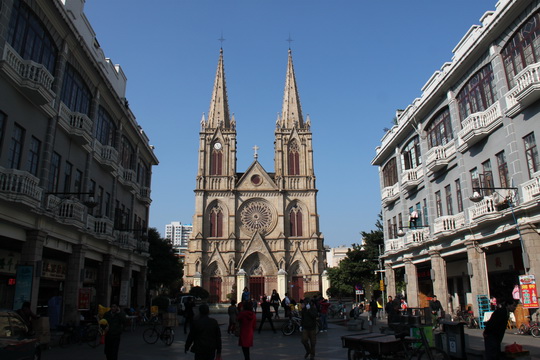
The Cathedral is a magnificent construction with walls and columns made of granite. It is well known both in the main land China,and oversea for its gothic architectural style and characteristic features of high towers, clusters of huge columns, pointed arches and stained glass windows.
It was founded 1863 and completed in 1888, date of the Feast of Sacred Heart which become the name of the Cathedral. It covers an area of some 2754 square meters, 35m west to east,78.69m high.
3. Stone Sculpture of Five Rams 广州五羊石像 (1959)
Yuexiu Park is the biggest park in Guangzhou. It belongs to the ending ranges of Baiyun Mountain, stretching for 3 kilometers from the east to the west with an altitude of over 70 meters.
There are many beautiful views and historical relics in the park. The Five-Ram Sculpture is one of the most famous structures in Yuexiu Park. If you want to travel around Guangzhou, Yuexiu Park is a good place for you to know about the city.
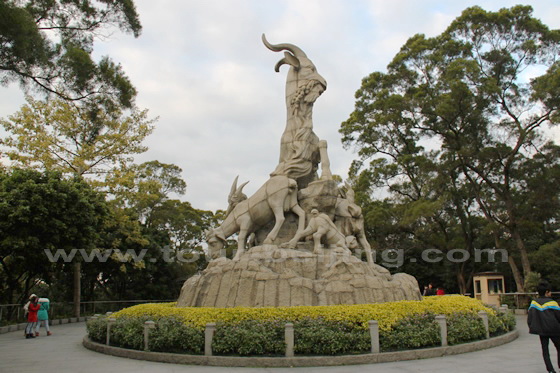
The Five Ram Statue is one of the emblems and landmarks in Guangzhou. Legend has it that five celestial immortals riding on rams arrived in town with rice stems which they presented to locals to get rid of poverty and famine as a gift from heaven. The sculpture was completed in 1959, and made of over 130 blocks of granite, 11 meters tall.
Entrance Fee: free
Opening Hours: 06:00-21:00
How to get there: You can get to the park by taking Bus No. 2, 5, 6, 10, 58, or 101, or taking Subway Line 2 to Yuexiu Gongyuan Station
4. Dr. Sun Yat-sen’s Memorial Hall 孙中山纪念堂(1931)
The Sun Yat-sen Memorial Hall is a large octagonal building with a span of 71 meters without pillars, accommodating a big stage and holds 3,240 people. It is one of Guangzhou City’s most well known landmarks. The hall was designed by Lu Yanzhi and was constructed with funds raised by local and overseas Chinese people in memory of Sun Yat-sen. Construction work started in 1929 and completed in 1931.
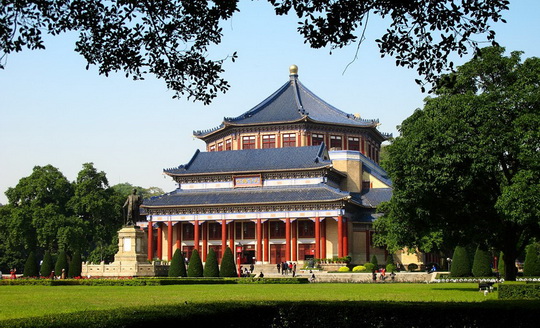
The exterior of the hall contains some gardens, and decorative historical walls. It has many wide open spaces where the people of Guangzhou often go to spend some time relaxing.
Entrance Fee: CNY 10
Opening Hours:08:00-18:00
How to get there: take Subway Line 2 to the Sun Yat-sen Memorial Hall; or take Buses No.2, 27, 42, 56, 62, 74, 80, 83, 133, 185, 204, 209, 224, 229, 261, 276, 284, 293, 297, 305, 518 or 543, Guangzhou
5. The Chen Clan Ancestral Hall 陈家祠 (1894)
The Chen Clan Ancestral Hall was originally built by the 72 Chen clans for the accommodation and preparation for the imperial examinations from Chen families in 1894 in Qing Dynasty. Later it was turned to be the Chen Clan’s Industry College, and later middle schools afterward.
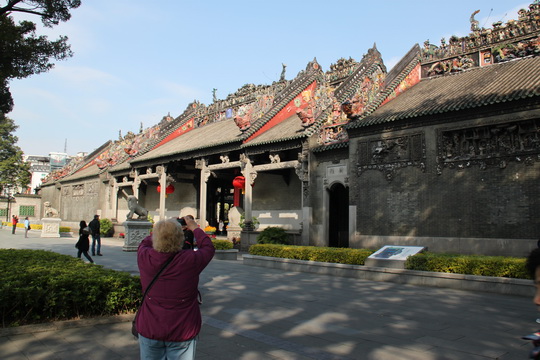
Now it is home to the Guangdong Folk Art. The Chen clan ancestral hall is famous for the ornate decoration which is presented inside and outside the halls. A large collection of wood carving, stone carving, brick carving, pottery, plaster and iron engraving are seen on the walls,beams, columns, ridges and soon, a trove of Chinese folk arts.
Entrance Fee: CNY 10
Opening Hours: 08:30-17:30
How to get there: take subway Line 1 to Chenjiaci Station
6. Canton Tower 广州塔 (2010)
Canton Tower( or Guangzhou Tower) is the tallest structure in Guangzhou, also known as the Guangzhou TV Astronomical & Sight Seeing Tower. It is a multi-purpose tower – Guangzhou TV, Observation, Recreation and Sightseeing with the height of 600 meters, the second tallest structure in China just after Shanghai Tower. It is the most essential landmark in Guangzhou, upgrading its image around the world.
The Canton Tower is designed by the Dutch architects Mark Hemel and Barbara Kuit of Information Based Architecture, together with Arup, the international design, engineering and business consulting firm headquartered in London, United Kingdom. The Canton tower is in a twisted shape or hyperboloid structure.
The Canton Tower is situated on the confluence of the city’s new axis and Zhujiang Sightseeing Axis, about 125 meters south of the Pearl River (Zhujiang River or Zhu River).
7. Guangzhou International Finance Center 广州国际金融中心 (广州西塔) 2010
Guangzhou International Finance Centre, also known as Guangzhou West Tower, is a 438.6-meter high skyscraper with 103 stories, a part of the Guangzhou Twin Towers.
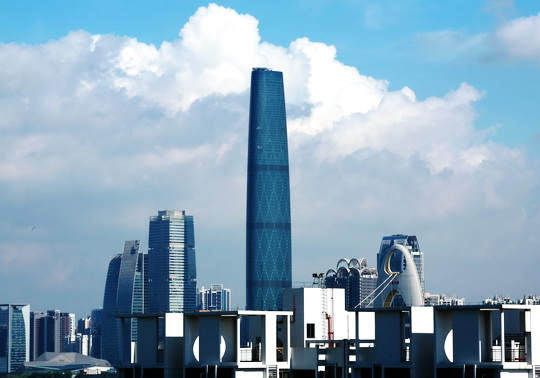
This highest building was designed by Wilkinson Eyre. Its construction started in 20015 and was completed in 2010. It is a multi-function building used for conference, hotel and office buildings. It is situated in the financial business center along the city’s new axis.
8. CITIC Plaza 广州中信广场 (1996)
China International Trust and Investment (CITIC) Plaza is a 391 meter skyscraper with an 80-storey in the Tianhe District of Guangzhou. It is the second tallest building in Guangzhou, one of the most iconic architectural landmarks in Guangzhou.
Its structural height includes two antenna-like spires on the top and completed in 1996. It is located along the city’snew axis, surrounded by other tall buildings, a symbol of Guangzhou’s booming wealth and development.
9. Pazhou International Exhibition Center 琶洲展馆 (2002)
The Guangzhou International Convention and Exhibition Center is located in Pazhou Island in the southeast of the central district of Guangzhou. Panzhou is the future central district of Guangzhou with many commercial and recreational facilities including the Guangzhou International Convention and Exhibition Center.
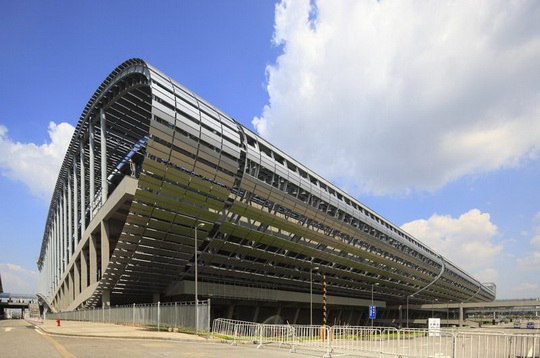
The Guangzhou International Convention and Exhibition Center has an area of 414000 square meters with the construction area of 395000 square meters. It has 13 exhibition halls with a total exhibition area of 130000 square meters.
It is a ultramodern building completed in 2002 with perfect combination of efficiency, intelligence, humanization and ecology. The main design principle of Exhibition Center is to promote the image of “flowing” of Pearl River. The wave like rooftop just likes the river flowing by. It meets the surrounding environment perfectly. This design principle is unique in all of the exhibition centres around the world.
10. Guangzhou Opera House 广州歌剧院 (2010)
Guangzhou Opera House is an opera house in Guangzhou. Now the theatre has become the biggest performing centre in southern China and is one of the three biggest theatres in China alongside Beijing’s National Centre for the Performing Arts and Shanghai’s Shanghai Grand Theatre.
It was designed by Zaha Hadid with the “Double Pebble”. Its freestanding concrete auditorium set within an exposed granite and glass-clad steel frame took over five years to build.
Any questions, just drop a line.





